Effects of Geometric and Crystallographic Factors on the Reliability of Al/Si Vertically Cracked Nanofilm/Substrate Systems
Abstract
:1. Introduction
2. Details of Atomistic Simulations
3. Results and Discussion
3.1. Stress–Strain Curves
3.2. Fracture Mechanisms
3.3. Mechanical Properties
4. Conclusions
Author Contributions
Funding
Institutional Review Board Statement
Informed Consent Statement
Data Availability Statement
Conflicts of Interest
References
- Wang, Y.; Li, Z.; Xiao, J. Stretchable thin film materials: Fabrication, application, and mechanics. J. Electron. Packag. 2016, 138, 020801. [Google Scholar] [CrossRef] [Green Version]
- Judy, J.W. Microelectromechanical systems (MEMS): Fabrication, design and applications. Smart Mater. Struct. 2001, 10, 1115–1134. [Google Scholar] [CrossRef] [Green Version]
- Smith, R.P.; Hwang, A.A.-C.; Beetz, T.; Helgren, E. Introduction to semiconductor processing: Fabrication and characterization of p-n junction silicon solar cells. Am. J. Phys. 2018, 86, 740. [Google Scholar] [CrossRef]
- Lee, S.; Choi, S.T.; Earmme, Y.Y. Analysis of vertical cracking phenomena in tensile-strained epitaxial film on a substrate: Part I. Mathematical formulation. Int. J. Solids Struct. 2006, 43, 3401–3413. [Google Scholar] [CrossRef] [Green Version]
- Beom, H.G.; Jang, H.S. Effect of elastic constants on crack channeling in a thin film bonded to an orthotropic substrate. Arch. Appl. Mech. 2013, 83, 1577–1589. [Google Scholar] [CrossRef]
- Xu, F.; Gong, D. Improved the elevated temperature mechanical properties of Al-Si alloy deposited with Al-Si coating by magnetron sputtering. Vacuum 2018, 150, 1–7. [Google Scholar] [CrossRef]
- Du, F.; Li, C.; Mi, Z.; Shen, Y.; Huang, R.; Han, X.; Dong, Y.; Xu, J. Anti-wear property of aluminum-silicon alloy treated by chemical etching, mechanical honing and laser finishing. Materials 2019, 12, 1273. [Google Scholar] [CrossRef] [Green Version]
- Liu, Y.-Q.; Fan, J.-Z.; Hao, X.-X.; Wei, S.-H.; Nie, J.-H.; Ma, Z.-L.; Liu, M.-K.; Wang, Y.-B. Advanced hermetic electronic packaging based on lightweight silicon/aluminum composite produced by powder metallurgy technique. Rare Met. 2020, 39, 1307–1313. [Google Scholar] [CrossRef]
- Tupaj, M.; Orłowicz, A.W.; Mróz, M.; Trytek, A.; Dolata, A.J.; Dziedzic, A. A study on material properties of intermetallic phases in a multicomponent hypereutectic Al-Si alloy with the use of nanoindentation testing. Materials 2020, 13, 5612. [Google Scholar] [CrossRef]
- Chen, Y.; Chung, D.D.L. Silicon-aluminium network composites fabricated by liquid metal infiltration. J. Mater. Sci. 1994, 29, 6069–6075. [Google Scholar] [CrossRef]
- Sangha, S.P.S.; Jacobson, D.M.; Ogilvy, A.J.W.; Azema, M.; Junai, A.A.; Botter, E. Novel aluminium-silicon alloys for electronics packaging. Eng. Sci. Educ. J. 1997, 6, 195–201. [Google Scholar] [CrossRef]
- Xie, X.; Zhang, J.; Li, M.; Liu, Q.; Mao, X. Design and fabrication of temperature-insensitive MEMS pressure sensor utilizing aluminum-silicon hybrid structures. IEEE Sens. J. 2021, 21, 5861–5870. [Google Scholar] [CrossRef]
- Zhu, Z.; Xia, K.; Fu, J.; Du, C.; Zhang, H.; Lou, H.; Xu, Z. Bonding of aluminum coated silicon wafers based on polypropylene carbonate and as a multi-functional sensor. Org. Electron. 2018, 63, 296–299. [Google Scholar] [CrossRef]
- Zhuo, X.R.; Beom, H.G. Size-dependent fracture properties of cracked silicon nanofilms. Mater. Sci. Eng. A-Struct. Mater. Prop. Microstruct. Process. 2015, 636, 470–475. [Google Scholar] [CrossRef]
- Ward, D.K.; Curtin, W.A.; Qi, Y. Aluminum-silicon interfaces and nanocomposites: A molecular dynamics study. Compos. Sci. Technol. 2006, 66, 1151–1161. [Google Scholar] [CrossRef]
- Zhuo, X.R.; Ma, A.; Beom, H.G. Cohesive zone representation of interfacial fracture in aluminum-silicon bimaterials. Comput. Mater. Sci. 2019, 169, 109105. [Google Scholar] [CrossRef]
- Plimpton, S. Fast parallel algorithms for short-range molecular dynamics. J. Comput. Phys. 1995, 117, 1–19. [Google Scholar] [CrossRef] [Green Version]
- FrantzDale, B.; Plimpton, S.J.; Shephard, M.S. Software components for parallel multiscale simulation: An example with LAMMPS. Eng. Comput. 2010, 26, 205–211. [Google Scholar] [CrossRef]
- Chaimovich, M.; Chaimovich, A. Relative resolution: A computationally efficient implementation in LAMMPS. J. Chem. Theory Comput. 2021, 17, 1045–1059. [Google Scholar] [CrossRef] [PubMed]
- Lindsay, L.; Broido, D.A.; Reinecke, T.L. Ab initio thermal transport in compound semiconductors. Phys. Rev. B 2013, 87, 165201. [Google Scholar] [CrossRef] [Green Version]
- Malica, C.; Dal Corso, A. Quasi-harmonic temperature dependent elastic constants: Applications to silicon, aluminum, and silver. J. Phys. Condens. Matter 2020, 32, 315902. [Google Scholar] [CrossRef] [PubMed]
- Baskes, M.I. Modified embedded-atom potentials for cubic materials and impurities. Phys. Rev. B 1992, 46, 2727. [Google Scholar] [CrossRef] [PubMed]
- Jelinek, B.; Groh, S.; Horstemeyer, M.F.; Houze, J.; Kim, S.G.; Wagner, G.J.; Moitra, A.; Baskes, M.I. Modified embedded atom method potential for Al, Si, Mg, Cu, and Fe alloys. Phys. Rev. B 2012, 85, 245102. [Google Scholar] [CrossRef] [Green Version]
- Gall, K.; Horstemeyer, M.F.; Van Schilfgaarde, M.; Baskes, M.I. Atomistic simulations on the tensile debonding of an aluminum-silicon interface. J. Mech. Phys. Solids 2000, 48, 2183–2212. [Google Scholar] [CrossRef]
- Noreyan, A.; Qi, Y.; Stoilov, V. Critical shear stresses at aluminum-silicon interfaces. Acta Mater. 2008, 56, 3461–3469. [Google Scholar] [CrossRef]
- Vallin, J.; Mongy, M.; Salama, K.; Beckman, O. Elastic constants of aluminum. J. Appl. Phys. 1964, 35, 1825. [Google Scholar] [CrossRef]
- Hall, J.J. Electronic effects in the elastic constants of n-type silicon. Phys. Rev. 1967, 161, 756. [Google Scholar] [CrossRef]
- Hestenes, M.R.; Stiefel, E. Methods of conjugate gradients for solving linear systems. J. Res. Natl. Bur. Stand. 1952, 49, 409–436. [Google Scholar] [CrossRef]
- Stukowski, A. Visualization and analysis of atomistic simulation data with OVITO-the Open Visualization Tool. Model. Simul. Mater. Sci. Eng. 2010, 18, 015012. [Google Scholar] [CrossRef]
- Swenson, R.J. Comments on virial theorems for bounded systems. Am. J. Phys. 1983, 51, 940. [Google Scholar] [CrossRef]
- Subramaniyan, A.K.; Sun, C.T. Continuum interpretation of virial stress in molecular simulations. Int. J. Solids Struct. 2008, 45, 4340–4346. [Google Scholar] [CrossRef] [Green Version]
- Kang, K.; Cai, W. Size and temperature effects on the fracture mechanisms of silicon nanowires: Molecular dynamics simulations. Int. J. Plast. 2010, 26, 1387–1401. [Google Scholar] [CrossRef]
- Xu, W.; Kim, W.K. Molecular dynamics simulation of the uniaxial tensile test of silicon nanowires using the MEAM potential. Mech. Mater. 2019, 137, 103140. [Google Scholar] [CrossRef]
- Sato, K.; Yoshioka, T.; Ando, T.; Shikida, M.; Kawabata, T. Tensile testing of silicon film having different crystallographic orientations carried out on a silicon chip. Sens. Actuator A-Phys. 1998, 70, 148–152. [Google Scholar] [CrossRef]
- Kelly, P.M.; Zhang, M.-X. Edge-to-edge matching-a new approach to the morphology and crystallography of precipitates. Mater. Forum 1999, 23, 41–62. [Google Scholar]
- Kelly, P.M.; Zhang, M.-X. Edge-to-edge matching-The fundamentals. Metall. Mater. Trans. A-Phys. Metall. Mater. Sci. 2006, 37, 833–839. [Google Scholar] [CrossRef]
- Shiflet, G.J.; Van Der Merwe, J.H. The role of structural ledges as misfit-compensating defects: Fcc-bcc interphase boundaries. Metall. Mater. Trans. A-Phys. Metall. Mater. Sci. 1994, 25, 1895–1903. [Google Scholar] [CrossRef]
- Cui, C.B.; Beom, H.G. Fracture of nanoscale Cu/Ag bimaterials with an interface crack. Comput. Mater. Sci. 2016, 118, 133–138. [Google Scholar] [CrossRef]
- Zhang, H.; Tersoff, J.; Xu, S.; Chen, H.; Zhang, Q.; Zhang, K.; Yang, Y.; Lee, C.-S.; Tu, K.-N.; Li, J.; et al. Approaching the ideal elastic strain limit in silicon nanowires. Sci. Adv. 2016, 2, e1501382. [Google Scholar] [CrossRef] [PubMed] [Green Version]
- Ji, C.; Park, H.S. The coupled effects of geometry and surface orientation on the mechanical properties of metal nanowires. Nanotechnology 2007, 18, 305704. [Google Scholar] [CrossRef]
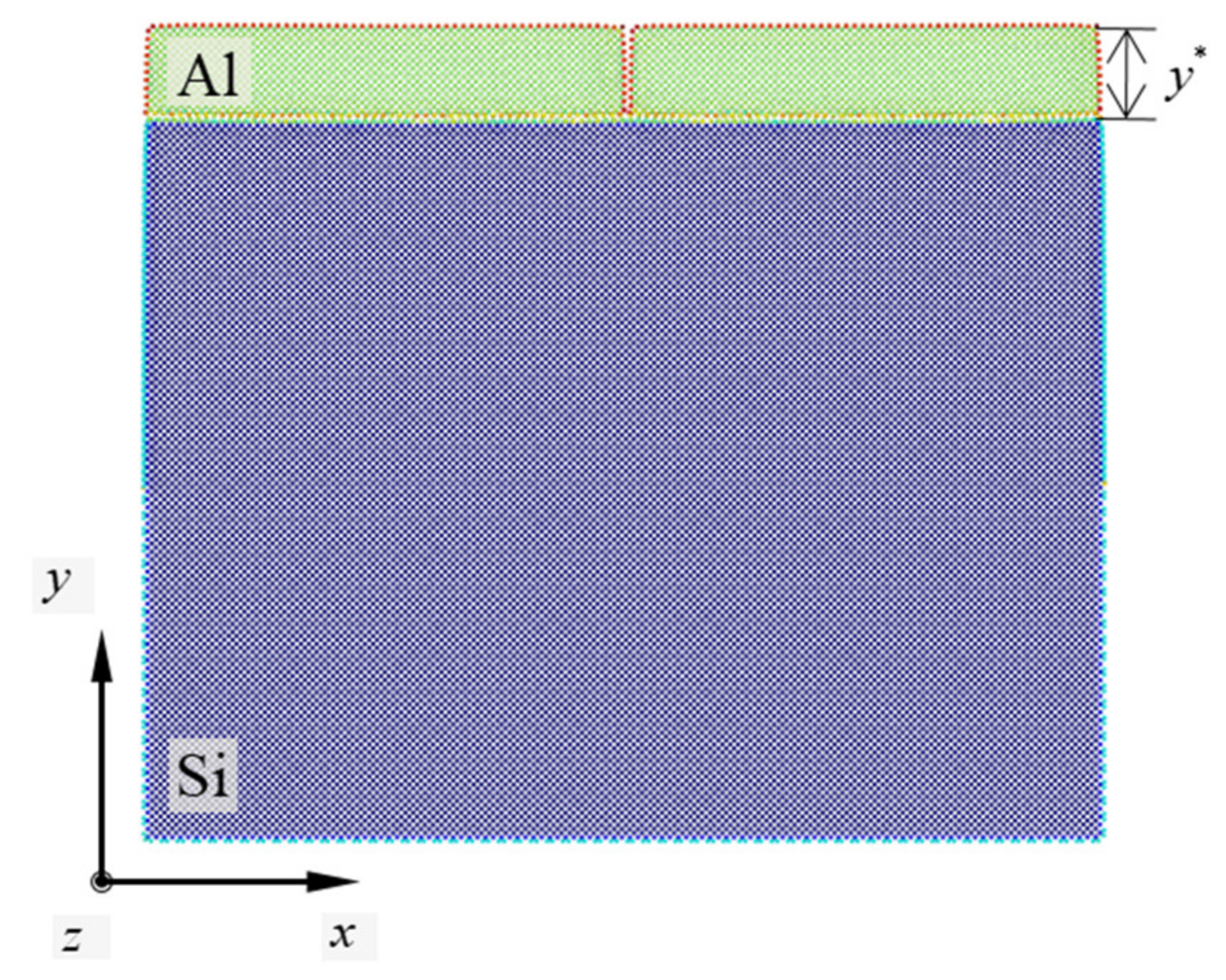
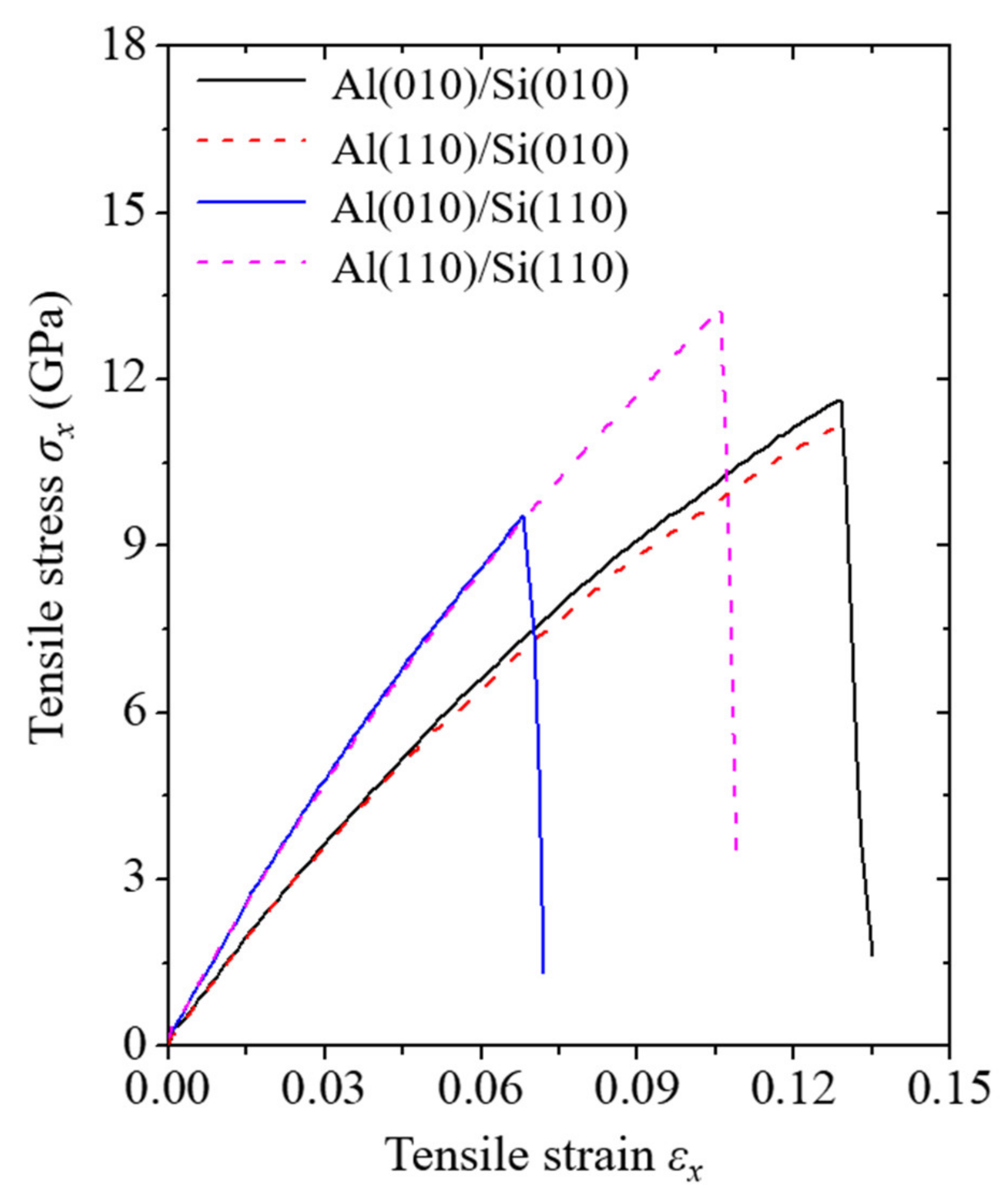
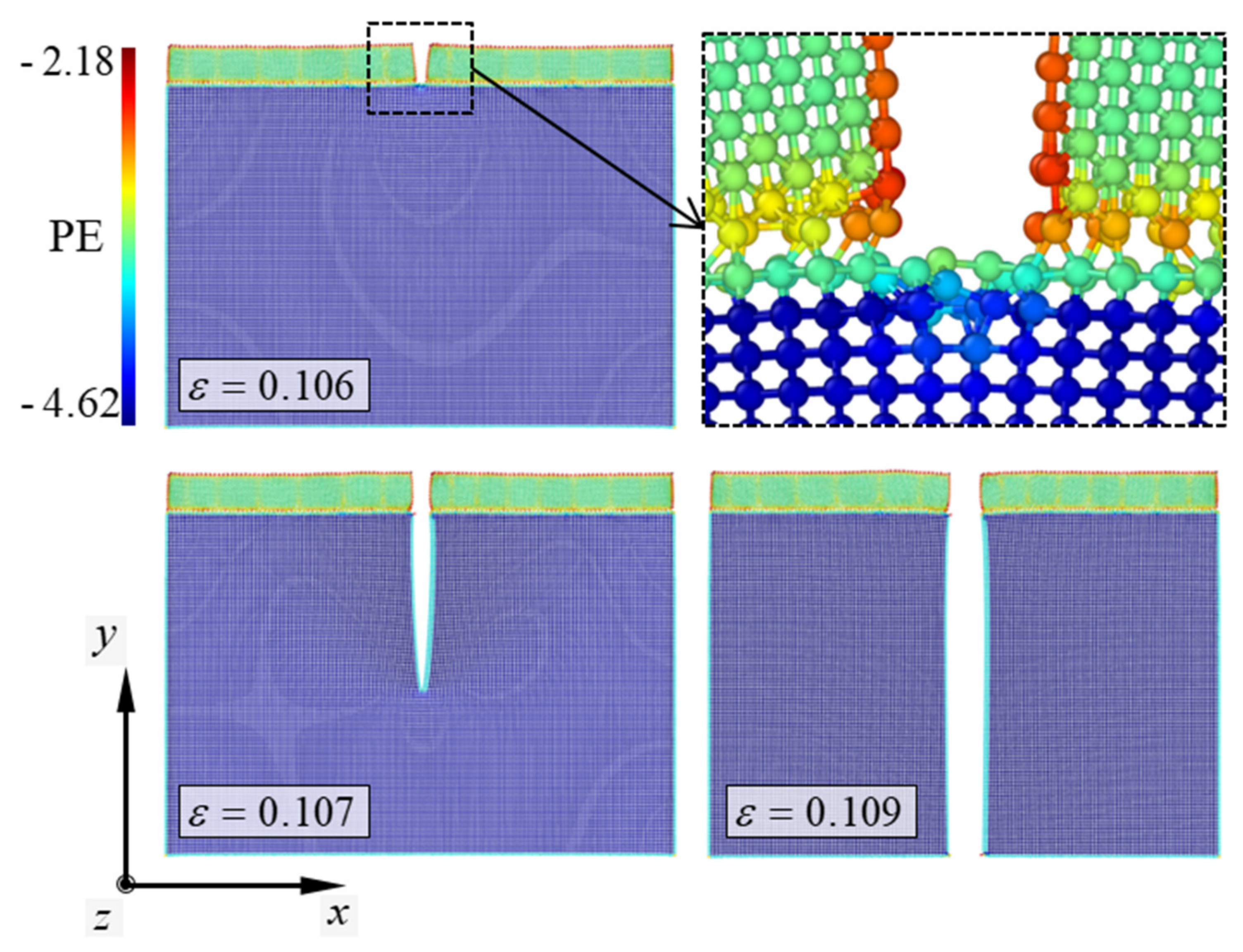

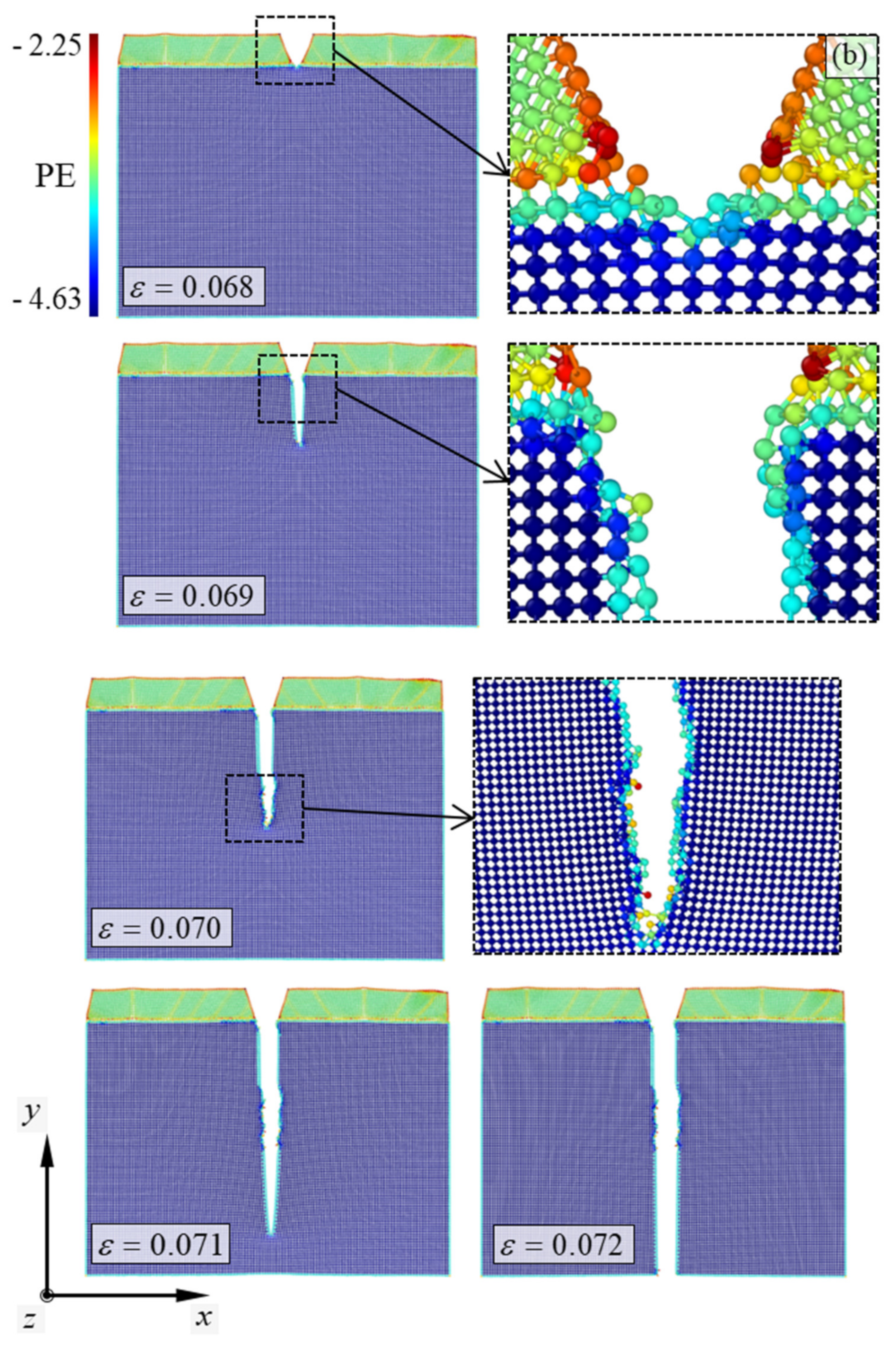
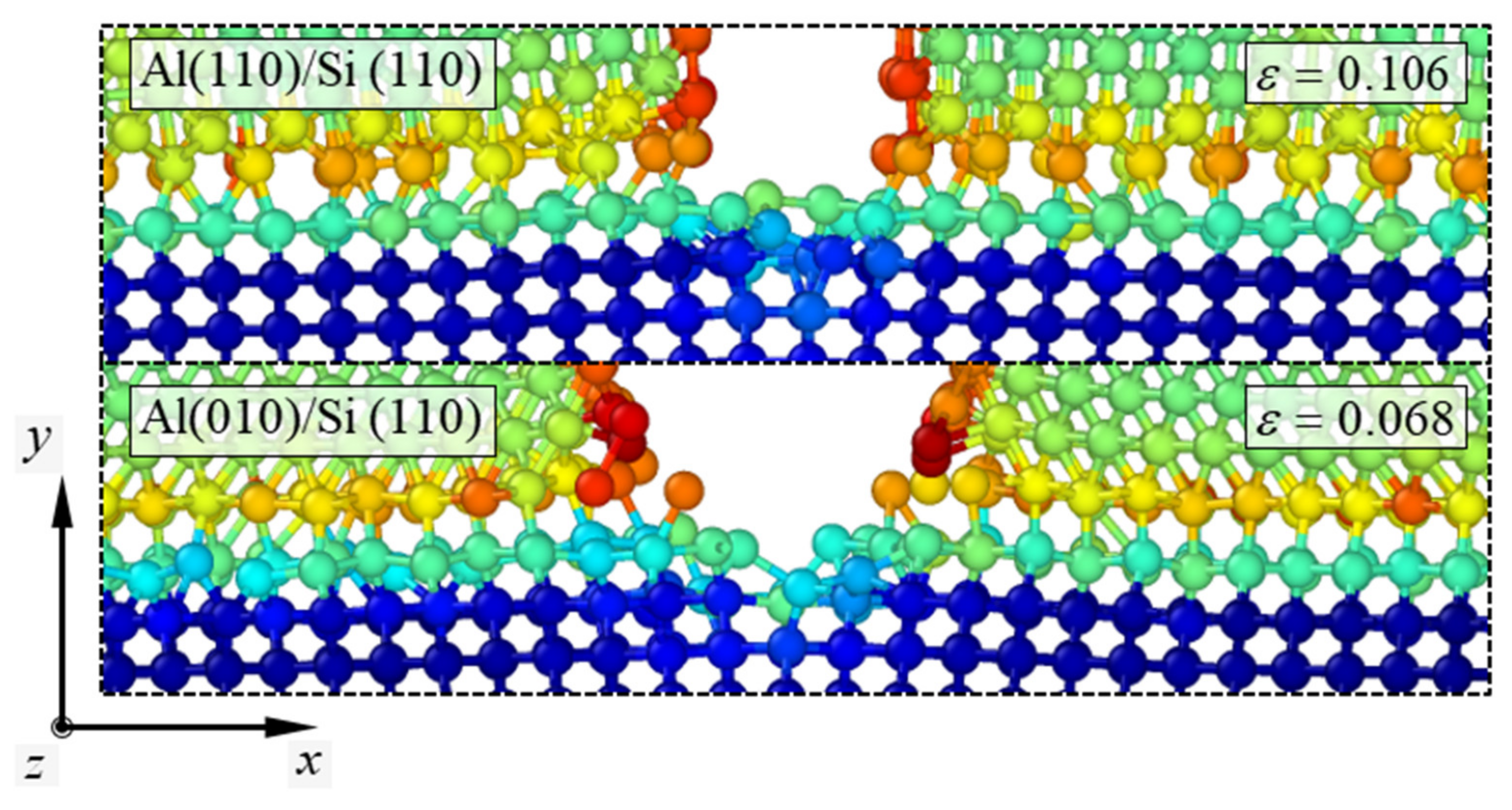
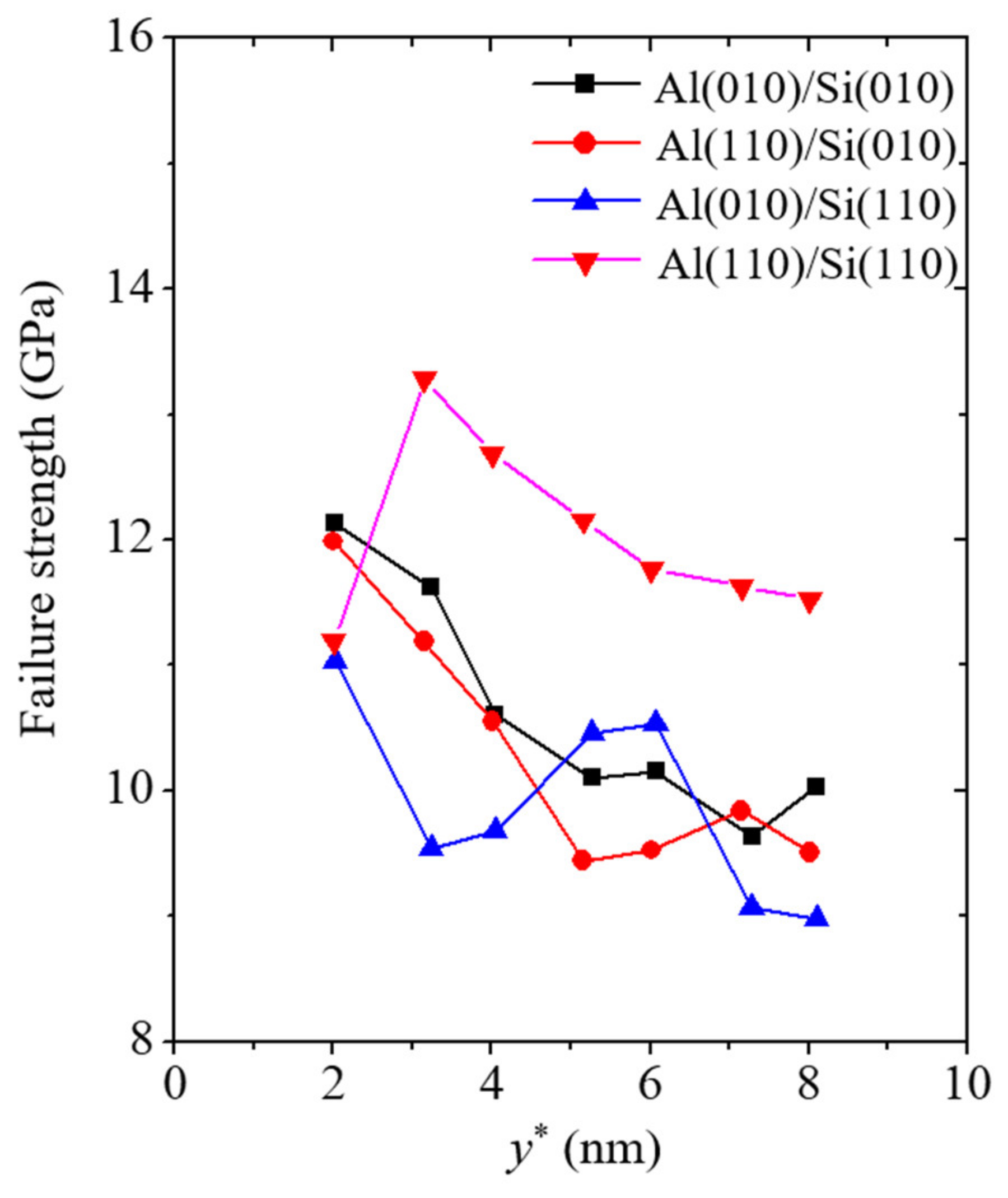


| Al | Si | |||
|---|---|---|---|---|
| MEAM | Experiment [26] | MEAM | Experiment [27] | |
| C11 | 110.81 | 116.3 | 165.63 | 165.64 |
| C12 | 61.1 | 64.8 | 63.88 | 63.94 |
| C44 | 28.72 | 30.9 | 83.93 | 79.51 |
| Length (nm) | Si(010) | Si(110) | Al(010) | Al(110) | |||
|---|---|---|---|---|---|---|---|
| x | 32.4 | 32.456 | 32.4 | 32.361 | |||
| y | 24.3 | 24.438 | y* | y* | |||
| z | 1.62 | 1.62 | 1.62 | 1.62 | |||
| y* of Al(010) | 2.025 | 3.24 | 4.05 | 5.265 | 6.075 | 7.29 | 8.1 |
| y* of Al(110) | 2.005 | 3.15 | 4.009 | 5.155 | 6.014 | 7.159 | 8.019 |
Publisher’s Note: MDPI stays neutral with regard to jurisdictional claims in published maps and institutional affiliations. |
© 2021 by the authors. Licensee MDPI, Basel, Switzerland. This article is an open access article distributed under the terms and conditions of the Creative Commons Attribution (CC BY) license (https://creativecommons.org/licenses/by/4.0/).
Share and Cite
Shim, J.S.; Go, D.H.; Beom, H.G. Effects of Geometric and Crystallographic Factors on the Reliability of Al/Si Vertically Cracked Nanofilm/Substrate Systems. Materials 2021, 14, 3570. https://doi.org/10.3390/ma14133570
Shim JS, Go DH, Beom HG. Effects of Geometric and Crystallographic Factors on the Reliability of Al/Si Vertically Cracked Nanofilm/Substrate Systems. Materials. 2021; 14(13):3570. https://doi.org/10.3390/ma14133570
Chicago/Turabian StyleShim, Jee S., Dong H. Go, and Hyeon G. Beom. 2021. "Effects of Geometric and Crystallographic Factors on the Reliability of Al/Si Vertically Cracked Nanofilm/Substrate Systems" Materials 14, no. 13: 3570. https://doi.org/10.3390/ma14133570
APA StyleShim, J. S., Go, D. H., & Beom, H. G. (2021). Effects of Geometric and Crystallographic Factors on the Reliability of Al/Si Vertically Cracked Nanofilm/Substrate Systems. Materials, 14(13), 3570. https://doi.org/10.3390/ma14133570






